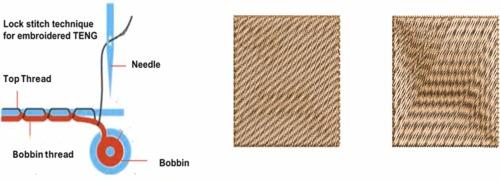Spatial engineering of textile threads for all-textile embroidered triboelectric nanogenerators
IF 17.1
1区 材料科学
Q1 CHEMISTRY, PHYSICAL
引用次数: 0
Abstract
Triboelectric nanogenerators (TENGs) are envisioned to become a leader in wearable energy-harvesting and self-powered sensing applications with textile-based TENGs playing a major role due to their comfort. However, textile TENGs face challenges including lower electrical outputs, low charge stability, and sporadic outputs, mainly due to lack of fibre/yarn-level TENG optimization strategies. These devices are predominantly constructed using fabric-level triboelectric modifications, at which stage, scope for their optimization is limited. Therefore, significant attention is needed to design and optimize fibre/yarn-level TENGs that can function as wearable sensors with excellent electrical, wearable, and mechanical performance. Herein, we introduce spatial engineering and optimisation techniques at fibre/yarn level of a textile using an embroidery technique to construct high-performance wearable TENG devices. For the first time, this work provides a comprehensive theoretical and experimental study on how fundamental embroidery parameters—such as stitch spacing, stitch length, and stitch direction—can be systematically varied to optimize TENG outputs, demonstrating significant increase in their performance. These TENGs were then used as self-powered active sensors for monitoring elbow movement on human subjects. Compared to gold-standard optoelectronic sensors and commercial inertial measurement units, these sensors provided excellent accuracy and repeatability, highlighting a landmark study in this research field.

全织物绣花摩擦电纳米发电机用纺织线的空间工程
摩擦电纳米发电机(TENGs)有望成为可穿戴能量收集和自供电传感应用的领导者,其中基于纺织品的TENGs因其舒适性而发挥着重要作用。然而,由于缺乏纤维/纱线级的TENG优化策略,纺织TENG面临着包括低电输出、低电荷稳定性和零星输出在内的挑战。这些设备主要使用织物级摩擦电修饰来构建,在这个阶段,它们的优化范围是有限的。因此,设计和优化纤维/纱线级的teng是非常重要的,它可以作为具有优异的电气、穿戴和机械性能的可穿戴传感器。在此,我们引入空间工程和优化技术,在纤维/纱线水平的纺织品使用刺绣技术来构建高性能的可穿戴TENG设备。这项工作首次提供了一个全面的理论和实验研究,研究如何系统地改变基本的刺绣参数,如针距、针长和针方向,以优化TENG输出,并证明了它们的性能显著提高。这些teng随后被用作自供电的主动传感器,用于监测人类受试者的肘部运动。与金标准光电传感器和商用惯性测量单元相比,这些传感器具有出色的精度和可重复性,在该研究领域具有里程碑式的意义。
本文章由计算机程序翻译,如有差异,请以英文原文为准。
求助全文
约1分钟内获得全文
求助全文
来源期刊

Nano Energy
CHEMISTRY, PHYSICAL-NANOSCIENCE & NANOTECHNOLOGY
CiteScore
30.30
自引率
7.40%
发文量
1207
审稿时长
23 days
期刊介绍:
Nano Energy is a multidisciplinary, rapid-publication forum of original peer-reviewed contributions on the science and engineering of nanomaterials and nanodevices used in all forms of energy harvesting, conversion, storage, utilization and policy. Through its mixture of articles, reviews, communications, research news, and information on key developments, Nano Energy provides a comprehensive coverage of this exciting and dynamic field which joins nanoscience and nanotechnology with energy science. The journal is relevant to all those who are interested in nanomaterials solutions to the energy problem.
Nano Energy publishes original experimental and theoretical research on all aspects of energy-related research which utilizes nanomaterials and nanotechnology. Manuscripts of four types are considered: review articles which inform readers of the latest research and advances in energy science; rapid communications which feature exciting research breakthroughs in the field; full-length articles which report comprehensive research developments; and news and opinions which comment on topical issues or express views on the developments in related fields.
 求助内容:
求助内容: 应助结果提醒方式:
应助结果提醒方式:


